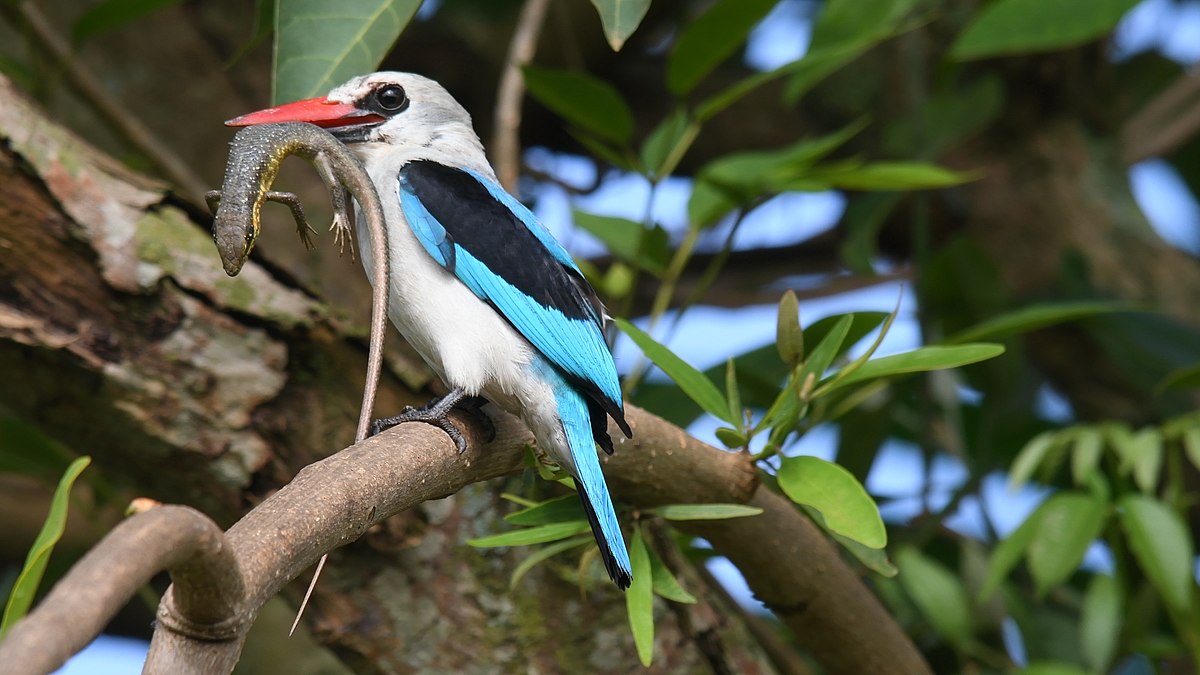The Woodland Kingfisher is an intra-African migrant, present on its austral breeding grounds during the summer. It occurs in the extreme north and, more extensively, in the northeastern parts of the atlas region. It is widely distributed in the savannas of the continent in two subspecies, with a third restricted to the rainforests of the equatorial belt.
Phylogenetically, it is not distantly removed from the forest-dwelling blue-breasted kingfisher “H. malimbica”, but does not form a superspecies with it. The Woodland and Mangrove “H. senegaloides” Kingfishers form a superspecies. But they differ in biology, vocalization, post-breeding movement patterns, bill coloration, and mass.
Birds with extensively or fully red bills have repeatedly been recorded. They closely resemble Mangrove kingfishers, with which they are regularly confused. In southern Africa, the ranges of the two species meet only in extreme northern KwaZulu-Natal.
However, on its breeding grounds, it is typically found in pairs, occupying relatively large territories, even in optimum habitat. It is maybe the most readily visible of the dry country, Halcyon spp., its characteristic trilling call drawing attention to its presence.
Habitat: It is found in well-developed woodland, particularly in tall riverine Acacia stands and Mopane, especially where the grass understorey is heavily grazed. It favors a country below 1000 m.
The reporting rates and pattern of distribution indicate that relative abundance in the Miombo woodlands of Zimbabwe is substantially lower than in woodland types further south in southern Zimbabwe (Mopane Woodland), the Transvaal (Mopane, Moist, and Arid Woodlands), and to the west in northern Botswana and the Caprivi (Okavango, Mopane).

Reporting rates were highest in Okavango, where it is common in swamp fringing woodland. Its preference for riverine woodland is illustrated by the strip of higher abundance along the Limpopo drainage on the Botswana–Transvaal border. It requires trees with holes for nesting. The Woodland Kingfisher is known as a tree kingfisher, which is widely distributed in the south of the Sahara, from Pretoria northwards.
Movements: The savanna races are migrants, whereas the forest form found north of southern Africa is largely sedentary, though a specimen has been collected on the Kunene River of Namibia, well to the south of the equatorial rainforests. Migrants arrive in the first two weeks of November, and the return migration takes place in mid-April.

Birds of the population stronghold in northern Botswana arrive about two weeks earlier than birds in southeastern Botswana, which form part of the Transvaal population. The atlas findings are similar; however, southern breeders of the race H. s. cyanoleuca spend the winter in equatorial Africa. Migratory movements are undertaken at night.
Breeding: Woodland Kingfisher breeding in the Transvaal takes place from November till March, thus, taking a peak in December and January. However, the data for Zimbabwe is comparable. There are two breeding records for October from Botswana.
The Atlas data agrees well with this. Woodland kingfisher prefers to make a nest in the other bird holes excavated by a barbet or woodpecker. Normally, 3 to 4 eggs are found in a single clutch of round white eggs. The chicks have been looked after by both parents for up to four to five weeks after leaving the nest.
Interspecific relationships: The medium-sized, electric-blue-backed kingfisher distribution overlaps almost everywhere with the Brown-hooded Kingfisher H. albiventris, and they frequently occur alongside each other. Although it is similar to the Mangrove Kingfisher in appearance, the two are largely allopatric, use different habitats and differ in their diet.
It has been recorded visiting Red-billed Quelea “Quelea quelea” colonies to feed on small chicks. This beautiful kingfisher is naturally very aggressive and known for attacking intruders, including humans. It has a wonderfully remarkable display in which the wings are spread to show the white linings and have a distinctive bicolored bill. Normally, this bird prefers drier conditions in more traditional woodland and can be found far away from water. It is a lot of solitude but can occur in small groups.
Historical distribution and conservation: The Woodland Kingfisher is not considered threatened at present, but is subject to some loss of numbers through accidents in built-up areas while on migration. Therefore, the consistent destruction of woodlands, particularly riparian woodlands, will have negative effects on the species. The woodland kingfisher hunts from a naked perch, habitually on a lifeless branch of a tree especially Acacias, or perches silently in semi-shade while seeking food.
Call / Song
As per ebird “It has loud and characteristic call is a high-pitched “tuuuui”, followed by a pause and then a trilling, down-slurred “trrrrrrrrrrrrrrrrrrr”. Sometimes it advertises by sitting upright, extending its wings to show a magnificent wing pattern, and calling”.
Read More: Black-headed Oriole







